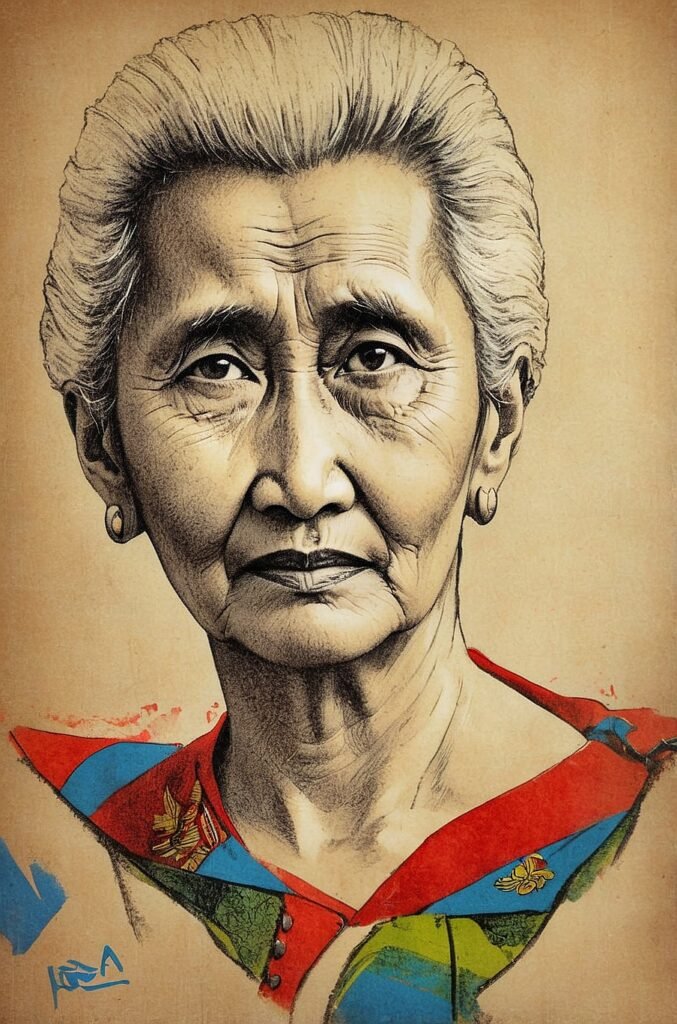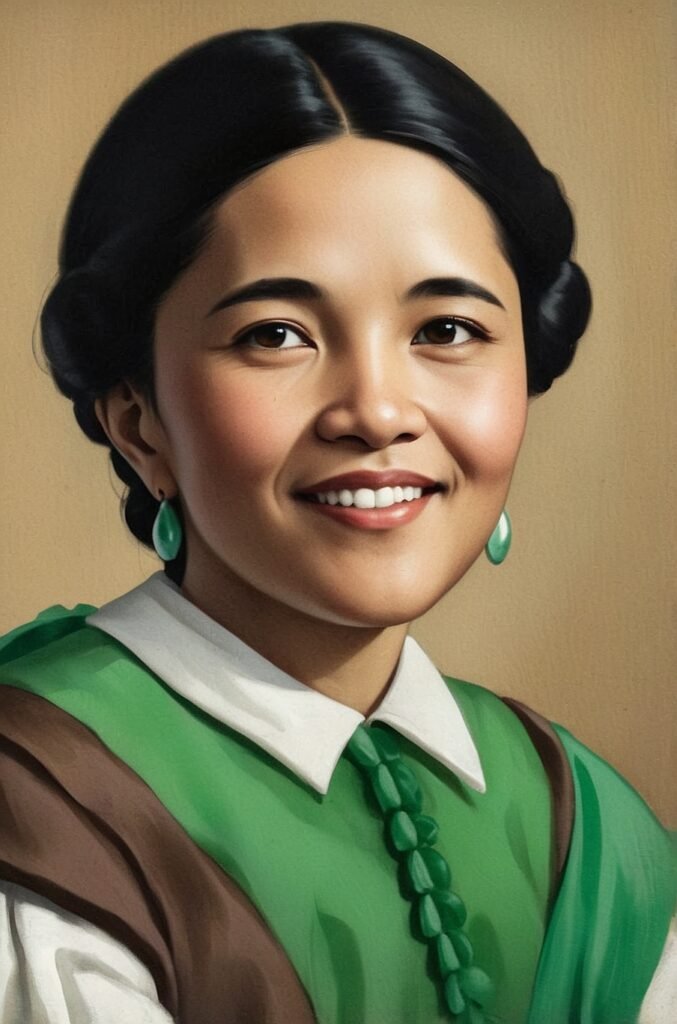Marina Dizon stands as a remarkable figure in Philippine history, embodying the spirit of revolution and the fight for independence during the late 19th century. As a member of the Katipunan, a secret revolutionary society, and a skilled spy, Dizon played a crucial role in the Philippine Revolution against Spanish colonial rule. This blog post delves into the life, contributions, and legacy of Marina Dizon, shedding light on her often-overlooked role in shaping the course of Philippine history.
Early Life and Background
Marina Dizon was born on July 18, 1875, in Trozo, Tondo, Manila, during a time of growing discontent with Spanish colonial rule in the Philippines. She came from a family of revolutionaries, which significantly influenced her future involvement in the independence movement. Her father, Jose Dizon, was a prominent member of the Katipunan and played a key role in the Philippine Revolution. This familial connection to the revolutionary cause would shape Marina’s path and inspire her future actions.
Growing up in Manila, Marina witnessed firsthand the inequalities and injustices perpetrated by the Spanish colonial government. The social and political climate of the late 19th century Philippines was marked by widespread discontent, economic exploitation, and a growing sense of national identity among the Filipino people. These factors contributed to the formation of secret societies like the Katipunan, which sought to overthrow Spanish rule and establish an independent Philippine nation.
Marina’s early education and experiences in this tumultuous environment laid the foundation for her later involvement in the revolutionary movement. Her upbringing in a politically active family exposed her to revolutionary ideas and instilled in her a deep sense of patriotism from a young age. This background would prove instrumental in shaping her future role as a Katipunera and spy.
Joining the Katipunan
The Katipunan and Its Objectives
The Katipunan, short for “Kataas-taasang, Kagalang-galangang Katipunan ng mga Anak ng Bayan” (Supreme and Venerable Association of the Children of the Nation), was a secret revolutionary society founded on July 7, 1892. Its primary objective was to gain independence from Spanish colonial rule through armed revolt. The organization operated in utmost secrecy, employing various codes, symbols, and rituals to protect its members and activities from Spanish authorities.
Marina’s Initiation
Marina Dizon’s initiation into the Katipunan occurred in 1893 when she was just 18 years old. Her father, Jose Dizon, introduced her to the organization, recognizing her potential to contribute to the revolutionary cause. Marina’s induction into the Katipunan was a significant event, as women were not commonly admitted to the society. Her acceptance demonstrated both her exceptional qualities and the organization’s recognition of the valuable role women could play in the revolution.
Roles and Responsibilities
As a member of the Katipunan, Marina took on various roles and responsibilities that were crucial to the organization’s operations. These included:
- Recruitment: Marina actively participated in recruiting new members to the Katipunan, particularly focusing on enlisting other women to support the cause.
- Fundraising: She helped organize events and activities to raise funds for the revolutionary movement, ensuring the Katipunan had the necessary resources to carry out its plans.
- Information dissemination: Marina played a key role in spreading information about the Katipunan’s objectives and activities among sympathizers and potential recruits.
- Support for male members: Like many women in the Katipunan, Marina provided crucial support to male members, including her father and other revolutionaries, by offering safe houses, delivering messages, and providing supplies.
Marina’s involvement in the Katipunan was not without risks. The Spanish colonial authorities were constantly on the lookout for members of revolutionary organizations, and discovery could lead to severe consequences, including imprisonment or execution. Despite these dangers, Marina remained committed to the cause of Philippine independence, demonstrating remarkable courage and dedication.
Marina Dizon as a Spy
Espionage Activities
One of Marina Dizon’s most significant contributions to the Philippine Revolution was her work as a spy. Her intelligence-gathering activities were crucial in providing the Katipunan with valuable information about Spanish colonial forces and their movements. Marina’s role as a spy involved several key aspects:
- Information gathering: Marina used her position and connections to collect intelligence on Spanish military plans, troop movements, and government decisions.
- Infiltration: She skillfully infiltrated Spanish social circles, gaining the trust of colonial officials and their families to access sensitive information.
- Message delivery: Marina acted as a courier, delivering coded messages between Katipunan members and cells, ensuring the flow of critical information within the organization.
- Risk assessment: Her work involved evaluating potential risks to the revolutionary movement and identifying opportunities for strategic action.
Techniques and Methods
Marina Dizon employed various espionage techniques to carry out her intelligence-gathering activities effectively:
- Social engineering: She used her charm and intelligence to build relationships with Spanish officials and their families, gaining their trust to access valuable information.
- Coded communications: Marina was proficient in the use of Katipunan codes and ciphers, allowing her to transmit sensitive information securely.
- Disguise and deception: When necessary, she would adopt different personas or disguises to move undetected and gather intelligence.
- Network building: Marina cultivated a network of informants and sympathizers who provided her with additional intelligence and support.
Impact on the Revolution
Marina Dizon’s espionage activities had a significant impact on the Philippine Revolution:
- Strategic advantage: The intelligence she gathered helped the Katipunan make informed decisions and plan their actions more effectively.
- Early warning system: Her work often provided advance notice of Spanish military operations, allowing revolutionaries to prepare or evade capture.
- Morale boost: Marina’s successful espionage activities boosted the morale of Katipunan members, demonstrating that they could outsmart their colonial oppressors.
- Inspiration for other women: Her role as a spy inspired other women to take active roles in the revolution, challenging traditional gender norms.
The following table summarizes Marina Dizon’s key espionage activities and their impact on the Philippine Revolution:
| Espionage Activity | Method | Impact |
|---|---|---|
| Information gathering | Social infiltration, eavesdropping | Provided strategic intelligence for Katipunan planning |
| Message delivery | Coded communications, disguise | Ensured secure flow of information within the organization |
| Risk assessment | Network building, analysis | Helped identify threats and opportunities for the revolution |
| Infiltration of Spanish circles | Social engineering, deception | Gained access to high-level colonial information |
Marina Dizon’s work as a spy was instrumental in advancing the cause of Philippine independence, demonstrating the crucial role that women played in the revolution beyond traditional supporting roles.
Women in the Philippine Revolution
The Changing Role of Women
The Philippine Revolution marked a significant shift in the role of women in Filipino society. Traditionally, women were expected to focus on domestic duties and remain largely uninvolved in political matters. However, the revolution provided an opportunity for women to step into more active and diverse roles, contributing significantly to the fight for independence.
Notable Women Revolutionaries
While Marina Dizon stands out for her espionage work, she was part of a larger group of women who made substantial contributions to the Philippine Revolution. Some other notable women revolutionaries include:
- Melchora Aquino: Known as “Tandang Sora,” she provided shelter, food, and medical care to Katipuneros.
- Teresa Magbanua: Nicknamed “Visayan Joan of Arc,” she led troops in battle against Spanish and American forces.
- Gregoria de Jesus: The wife of Katipunan founder Andres Bonifacio, she played a crucial role in the organization’s operations.
- Trinidad Tecson: Known as the “Mother of Biak-na-Bato,” she fought in battles and provided medical support to revolutionary forces.
Contributions of Women to the Revolution
Women’s contributions to the Philippine Revolution were diverse and significant:
- Intelligence gathering: Like Marina Dizon, many women served as spies and informants.
- Logistics and support: Women provided food, shelter, and medical care to revolutionaries.
- Fundraising: They organized events and activities to raise funds for the revolutionary cause.
- Combat roles: Some women participated directly in armed conflict against colonial forces.
- Propaganda and education: Women helped spread revolutionary ideas and educate others about the cause of independence.
The following chart illustrates the various roles women played in the Philippine Revolution:
pie title Roles of Women in the Philippine Revolution
"Intelligence gathering" : 25
"Logistics and support" : 30
"Fundraising" : 20
"Combat roles" : 10
"Propaganda and education" : 15The involvement of women like Marina Dizon in the Philippine Revolution challenged traditional gender roles and paved the way for greater gender equality in Philippine society. Their contributions demonstrated that women were capable of playing crucial roles in nation-building and political movements, setting a precedent for future generations of Filipino women.
Legacy and Impact
Marina Dizon’s Lasting Influence
Marina Dizon’s contributions to the Philippine Revolution left a lasting impact on the country’s history and social fabric. Her legacy extends beyond her immediate actions during the revolutionary period and continues to influence Philippine society in several ways:
- Inspiration for women’s empowerment: Marina’s role as a Katipunera and spy serves as an inspiration for Filipino women, encouraging them to take active roles in politics, governance, and nation-building.
- Recognition of women’s contributions: Her story has helped highlight the often-overlooked contributions of women to Philippine history, leading to greater recognition and study of women’s roles in historical events.
- Advancement of gender equality: Marina’s actions challenged traditional gender norms, contributing to the gradual advancement of gender equality in Philippine society.
- Promotion of patriotism and civic engagement: Her dedication to the cause of independence continues to inspire Filipinos to actively participate in civic affairs and work towards the betterment of their country.
Commemoration and Recognition
Marina Dizon’s contributions to the Philippine Revolution have been recognized and commemorated in various ways:
- Historical records: Her story has been included in historical accounts and textbooks, ensuring that future generations learn about her role in the struggle for independence.
- Monuments and memorials: Several monuments and historical markers honor Marina Dizon and other women revolutionaries across the Philippines.
- Street names: Some municipalities have named streets after Marina Dizon to commemorate her contributions.
- Cultural representations: Her life and actions have been depicted in literature, art, and media, further cementing her place in Philippine cultural memory.
Impact on Philippine Historiography
The recognition of Marina Dizon’s role in the Philippine Revolution has had a significant impact on how Philippine history is studied and understood:
- Expanded narrative: The inclusion of women like Marina in historical accounts has broadened the narrative of the Philippine Revolution, providing a more comprehensive understanding of the event.
- Gender perspective in historical studies: Her story has encouraged historians to consider gender perspectives when examining historical events, leading to more nuanced and inclusive historical analyses.
- Reexamination of women’s roles: Marina’s contributions have prompted a reexamination of women’s roles in other historical periods and events, leading to new discoveries and interpretations.
- Inspiration for further research: The recognition of Marina’s story has inspired researchers to delve deeper into the lives and contributions of other women in Philippine history.
The following timeline illustrates key events in Marina Dizon’s life and her lasting impact:
timeline
title Marina Dizon's Life and Legacy
1875 : Born in Trozo, Tondo, Manila
1893 : Joined the Katipunan at age 18
1896-1898 : Active as a spy during the Philippine Revolution
1900s-1950s : Continued involvement in civic affairs
1950 onwards : Growing recognition of her contributions
Present day : Ongoing commemoration and historical studiesMarina Dizon’s legacy serves as a testament to the crucial role that individuals, particularly women, can play in shaping the course of history. Her story continues to inspire Filipinos and people around the world, reminding us of the power of courage, dedication, and the pursuit of freedom and equality.
Conclusion
Marina Dizon’s life and contributions to the Philippine Revolution exemplify the often-unsung role of women in shaping the course of history. As a Katipunera and spy, she demonstrated exceptional courage, intelligence, and dedication to the cause of Philippine independence. Her story challenges traditional narratives of revolution and nation-building, highlighting the diverse ways in which individuals, regardless of gender, can contribute to social and political change.
The legacy of Marina Dizon extends far beyond her immediate actions during the revolutionary period. Her life serves as an inspiration for future generations, particularly women, encouraging active participation in civic affairs and the ongoing work of nation-building. The recognition of her contributions has also led to a broader reexamination of women’s roles in Philippine history, enriching our understanding of the country’s past and informing its future.
As we reflect on Marina Dizon’s life and the larger context of women’s involvement in the Philippine Revolution, we are reminded of the importance of inclusivity in historical narratives. By acknowledging and celebrating the diverse contributions of all members of society, we gain a more comprehensive and nuanced understanding of our shared history.
Marina Dizon’s story is not just a tale of individual heroism, but a testament to the collective power of a people united in the pursuit of freedom and justice. Her legacy continues to resonate in the Philippines and beyond, inspiring individuals to stand up for their beliefs, challenge oppression, and work towards a more equitable society.
As we move forward, it is crucial to continue uncovering and sharing stories like Marina Dizon’s, ensuring that the full tapestry of our history is recognized and celebrated. In doing so, we honor the sacrifices of those who came before us and pave the way for a more inclusive and just future.
Disclaimer: This blog post is based on historical records and research available at the time of writing. While every effort has been made to ensure accuracy, some details may be subject to interpretation or ongoing historical debate. We encourage readers to engage in further research and to report any inaccuracies so that we can correct them promptly. Our understanding of history is continually evolving, and we welcome new insights that contribute to a more comprehensive understanding of Marina Dizon’s life and the Philippine Revolution.




